Competitive Strategy: PESTEL Analysis, Five Forces Framework, SWOT Analysis, Resource-based View
VerifiedAdded on 2023/01/23
|7
|1817
|83
AI Summary
This document discusses the competitive strategy of PESTEL analysis, five forces framework, SWOT analysis, and resource-based view. It explains how these tools can help companies evaluate external factors, identify strengths and weaknesses, and generate a competitive advantage. Examples of companies like Apple, Starbucks, and Google are provided to illustrate the application of these strategies.
Contribute Materials
Your contribution can guide someone’s learning journey. Share your
documents today.

Competitive Strategy
2019
2019
Secure Best Marks with AI Grader
Need help grading? Try our AI Grader for instant feedback on your assignments.
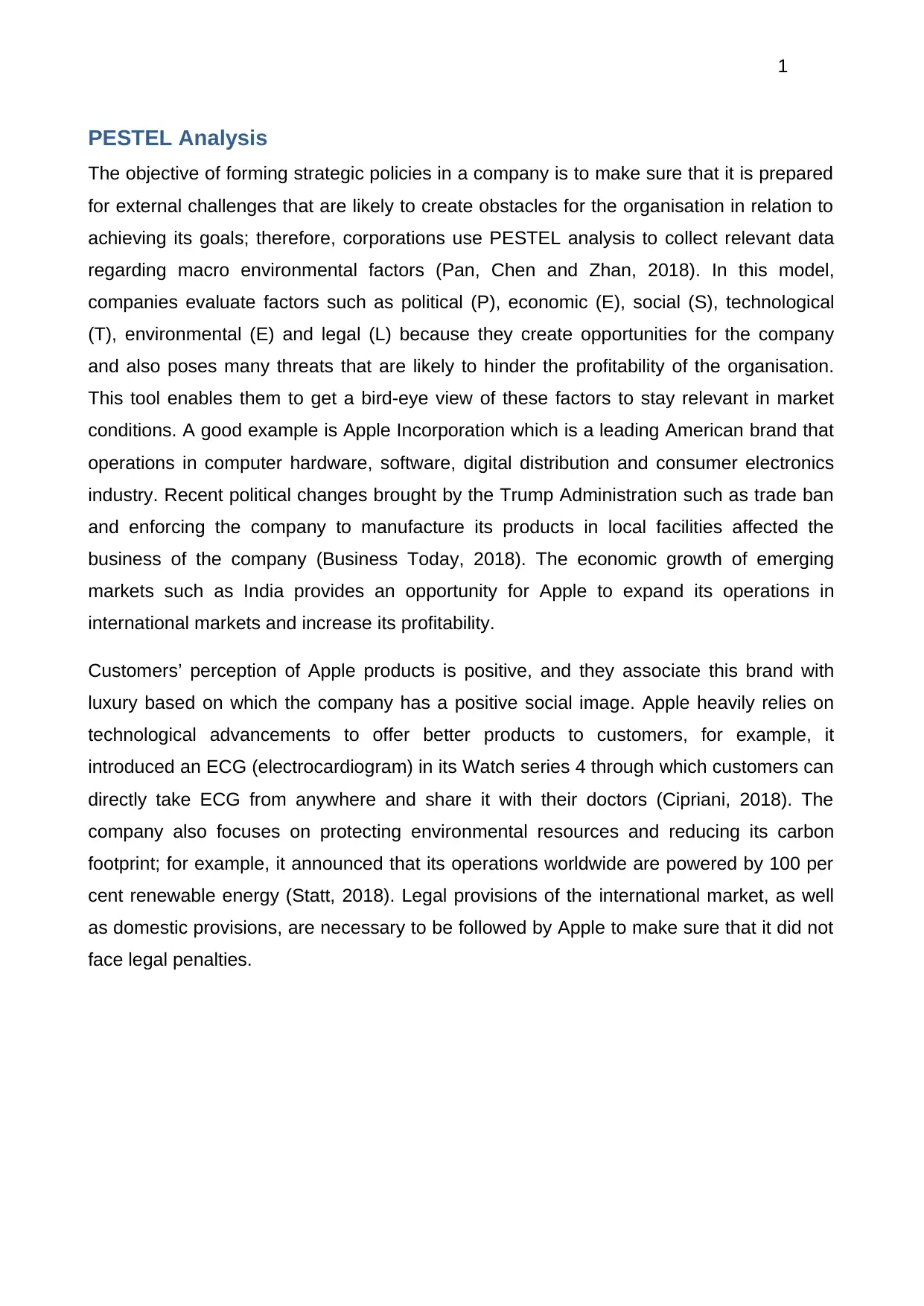
1
PESTEL Analysis
The objective of forming strategic policies in a company is to make sure that it is prepared
for external challenges that are likely to create obstacles for the organisation in relation to
achieving its goals; therefore, corporations use PESTEL analysis to collect relevant data
regarding macro environmental factors (Pan, Chen and Zhan, 2018). In this model,
companies evaluate factors such as political (P), economic (E), social (S), technological
(T), environmental (E) and legal (L) because they create opportunities for the company
and also poses many threats that are likely to hinder the profitability of the organisation.
This tool enables them to get a bird-eye view of these factors to stay relevant in market
conditions. A good example is Apple Incorporation which is a leading American brand that
operations in computer hardware, software, digital distribution and consumer electronics
industry. Recent political changes brought by the Trump Administration such as trade ban
and enforcing the company to manufacture its products in local facilities affected the
business of the company (Business Today, 2018). The economic growth of emerging
markets such as India provides an opportunity for Apple to expand its operations in
international markets and increase its profitability.
Customers’ perception of Apple products is positive, and they associate this brand with
luxury based on which the company has a positive social image. Apple heavily relies on
technological advancements to offer better products to customers, for example, it
introduced an ECG (electrocardiogram) in its Watch series 4 through which customers can
directly take ECG from anywhere and share it with their doctors (Cipriani, 2018). The
company also focuses on protecting environmental resources and reducing its carbon
footprint; for example, it announced that its operations worldwide are powered by 100 per
cent renewable energy (Statt, 2018). Legal provisions of the international market, as well
as domestic provisions, are necessary to be followed by Apple to make sure that it did not
face legal penalties.
PESTEL Analysis
The objective of forming strategic policies in a company is to make sure that it is prepared
for external challenges that are likely to create obstacles for the organisation in relation to
achieving its goals; therefore, corporations use PESTEL analysis to collect relevant data
regarding macro environmental factors (Pan, Chen and Zhan, 2018). In this model,
companies evaluate factors such as political (P), economic (E), social (S), technological
(T), environmental (E) and legal (L) because they create opportunities for the company
and also poses many threats that are likely to hinder the profitability of the organisation.
This tool enables them to get a bird-eye view of these factors to stay relevant in market
conditions. A good example is Apple Incorporation which is a leading American brand that
operations in computer hardware, software, digital distribution and consumer electronics
industry. Recent political changes brought by the Trump Administration such as trade ban
and enforcing the company to manufacture its products in local facilities affected the
business of the company (Business Today, 2018). The economic growth of emerging
markets such as India provides an opportunity for Apple to expand its operations in
international markets and increase its profitability.
Customers’ perception of Apple products is positive, and they associate this brand with
luxury based on which the company has a positive social image. Apple heavily relies on
technological advancements to offer better products to customers, for example, it
introduced an ECG (electrocardiogram) in its Watch series 4 through which customers can
directly take ECG from anywhere and share it with their doctors (Cipriani, 2018). The
company also focuses on protecting environmental resources and reducing its carbon
footprint; for example, it announced that its operations worldwide are powered by 100 per
cent renewable energy (Statt, 2018). Legal provisions of the international market, as well
as domestic provisions, are necessary to be followed by Apple to make sure that it did not
face legal penalties.
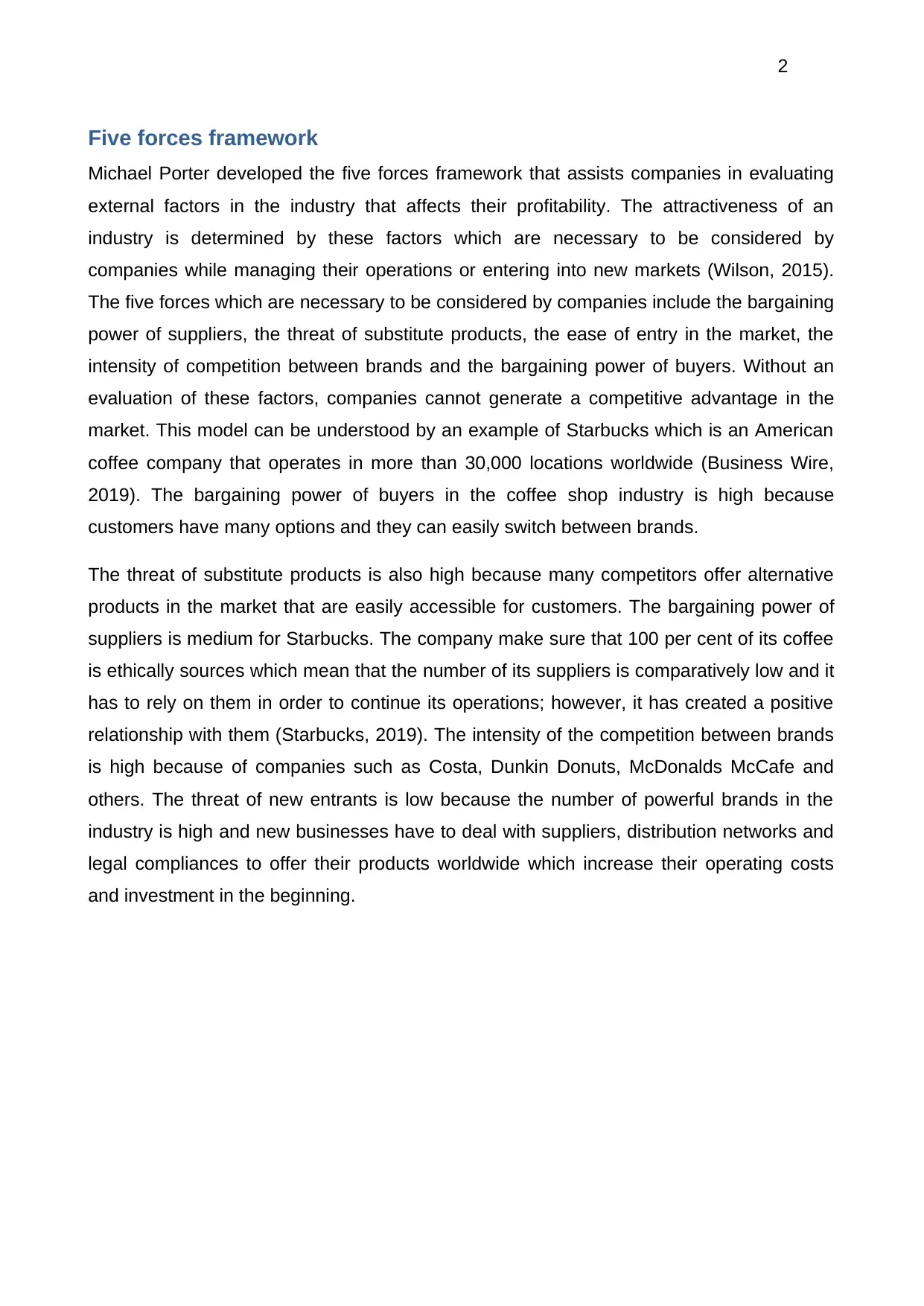
2
Five forces framework
Michael Porter developed the five forces framework that assists companies in evaluating
external factors in the industry that affects their profitability. The attractiveness of an
industry is determined by these factors which are necessary to be considered by
companies while managing their operations or entering into new markets (Wilson, 2015).
The five forces which are necessary to be considered by companies include the bargaining
power of suppliers, the threat of substitute products, the ease of entry in the market, the
intensity of competition between brands and the bargaining power of buyers. Without an
evaluation of these factors, companies cannot generate a competitive advantage in the
market. This model can be understood by an example of Starbucks which is an American
coffee company that operates in more than 30,000 locations worldwide (Business Wire,
2019). The bargaining power of buyers in the coffee shop industry is high because
customers have many options and they can easily switch between brands.
The threat of substitute products is also high because many competitors offer alternative
products in the market that are easily accessible for customers. The bargaining power of
suppliers is medium for Starbucks. The company make sure that 100 per cent of its coffee
is ethically sources which mean that the number of its suppliers is comparatively low and it
has to rely on them in order to continue its operations; however, it has created a positive
relationship with them (Starbucks, 2019). The intensity of the competition between brands
is high because of companies such as Costa, Dunkin Donuts, McDonalds McCafe and
others. The threat of new entrants is low because the number of powerful brands in the
industry is high and new businesses have to deal with suppliers, distribution networks and
legal compliances to offer their products worldwide which increase their operating costs
and investment in the beginning.
Five forces framework
Michael Porter developed the five forces framework that assists companies in evaluating
external factors in the industry that affects their profitability. The attractiveness of an
industry is determined by these factors which are necessary to be considered by
companies while managing their operations or entering into new markets (Wilson, 2015).
The five forces which are necessary to be considered by companies include the bargaining
power of suppliers, the threat of substitute products, the ease of entry in the market, the
intensity of competition between brands and the bargaining power of buyers. Without an
evaluation of these factors, companies cannot generate a competitive advantage in the
market. This model can be understood by an example of Starbucks which is an American
coffee company that operates in more than 30,000 locations worldwide (Business Wire,
2019). The bargaining power of buyers in the coffee shop industry is high because
customers have many options and they can easily switch between brands.
The threat of substitute products is also high because many competitors offer alternative
products in the market that are easily accessible for customers. The bargaining power of
suppliers is medium for Starbucks. The company make sure that 100 per cent of its coffee
is ethically sources which mean that the number of its suppliers is comparatively low and it
has to rely on them in order to continue its operations; however, it has created a positive
relationship with them (Starbucks, 2019). The intensity of the competition between brands
is high because of companies such as Costa, Dunkin Donuts, McDonalds McCafe and
others. The threat of new entrants is low because the number of powerful brands in the
industry is high and new businesses have to deal with suppliers, distribution networks and
legal compliances to offer their products worldwide which increase their operating costs
and investment in the beginning.
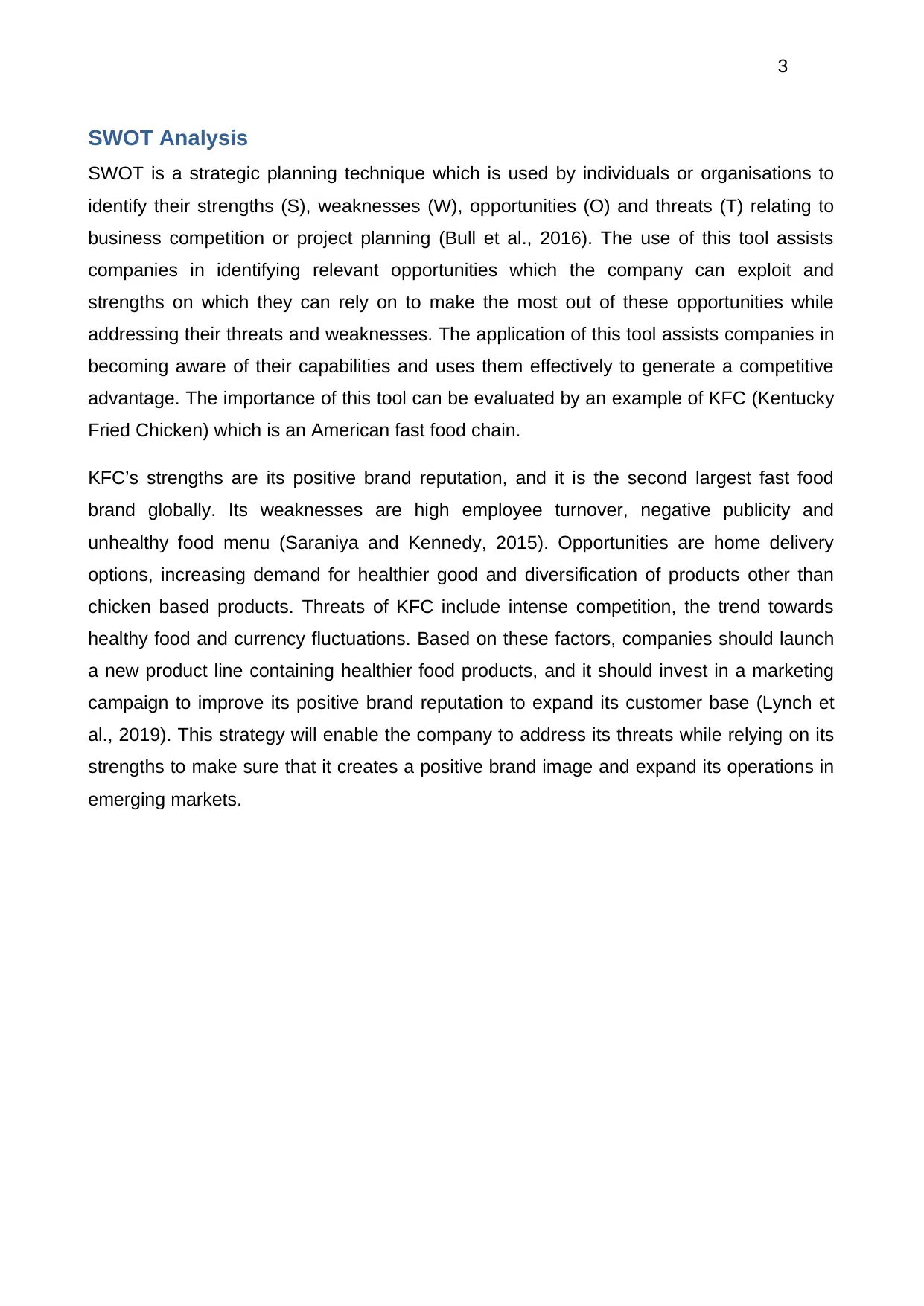
3
SWOT Analysis
SWOT is a strategic planning technique which is used by individuals or organisations to
identify their strengths (S), weaknesses (W), opportunities (O) and threats (T) relating to
business competition or project planning (Bull et al., 2016). The use of this tool assists
companies in identifying relevant opportunities which the company can exploit and
strengths on which they can rely on to make the most out of these opportunities while
addressing their threats and weaknesses. The application of this tool assists companies in
becoming aware of their capabilities and uses them effectively to generate a competitive
advantage. The importance of this tool can be evaluated by an example of KFC (Kentucky
Fried Chicken) which is an American fast food chain.
KFC’s strengths are its positive brand reputation, and it is the second largest fast food
brand globally. Its weaknesses are high employee turnover, negative publicity and
unhealthy food menu (Saraniya and Kennedy, 2015). Opportunities are home delivery
options, increasing demand for healthier good and diversification of products other than
chicken based products. Threats of KFC include intense competition, the trend towards
healthy food and currency fluctuations. Based on these factors, companies should launch
a new product line containing healthier food products, and it should invest in a marketing
campaign to improve its positive brand reputation to expand its customer base (Lynch et
al., 2019). This strategy will enable the company to address its threats while relying on its
strengths to make sure that it creates a positive brand image and expand its operations in
emerging markets.
SWOT Analysis
SWOT is a strategic planning technique which is used by individuals or organisations to
identify their strengths (S), weaknesses (W), opportunities (O) and threats (T) relating to
business competition or project planning (Bull et al., 2016). The use of this tool assists
companies in identifying relevant opportunities which the company can exploit and
strengths on which they can rely on to make the most out of these opportunities while
addressing their threats and weaknesses. The application of this tool assists companies in
becoming aware of their capabilities and uses them effectively to generate a competitive
advantage. The importance of this tool can be evaluated by an example of KFC (Kentucky
Fried Chicken) which is an American fast food chain.
KFC’s strengths are its positive brand reputation, and it is the second largest fast food
brand globally. Its weaknesses are high employee turnover, negative publicity and
unhealthy food menu (Saraniya and Kennedy, 2015). Opportunities are home delivery
options, increasing demand for healthier good and diversification of products other than
chicken based products. Threats of KFC include intense competition, the trend towards
healthy food and currency fluctuations. Based on these factors, companies should launch
a new product line containing healthier food products, and it should invest in a marketing
campaign to improve its positive brand reputation to expand its customer base (Lynch et
al., 2019). This strategy will enable the company to address its threats while relying on its
strengths to make sure that it creates a positive brand image and expand its operations in
emerging markets.
Secure Best Marks with AI Grader
Need help grading? Try our AI Grader for instant feedback on your assignments.
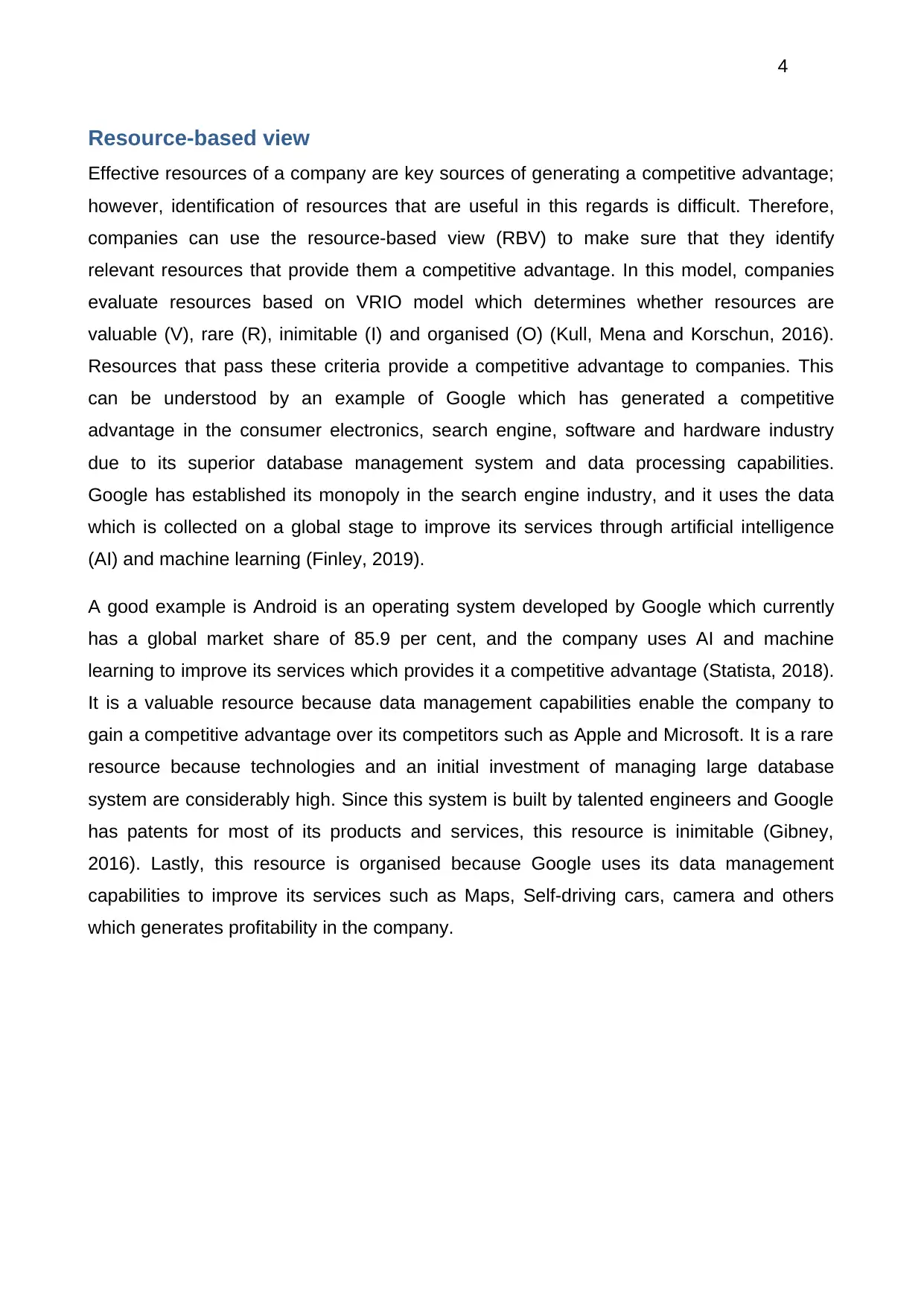
4
Resource-based view
Effective resources of a company are key sources of generating a competitive advantage;
however, identification of resources that are useful in this regards is difficult. Therefore,
companies can use the resource-based view (RBV) to make sure that they identify
relevant resources that provide them a competitive advantage. In this model, companies
evaluate resources based on VRIO model which determines whether resources are
valuable (V), rare (R), inimitable (I) and organised (O) (Kull, Mena and Korschun, 2016).
Resources that pass these criteria provide a competitive advantage to companies. This
can be understood by an example of Google which has generated a competitive
advantage in the consumer electronics, search engine, software and hardware industry
due to its superior database management system and data processing capabilities.
Google has established its monopoly in the search engine industry, and it uses the data
which is collected on a global stage to improve its services through artificial intelligence
(AI) and machine learning (Finley, 2019).
A good example is Android is an operating system developed by Google which currently
has a global market share of 85.9 per cent, and the company uses AI and machine
learning to improve its services which provides it a competitive advantage (Statista, 2018).
It is a valuable resource because data management capabilities enable the company to
gain a competitive advantage over its competitors such as Apple and Microsoft. It is a rare
resource because technologies and an initial investment of managing large database
system are considerably high. Since this system is built by talented engineers and Google
has patents for most of its products and services, this resource is inimitable (Gibney,
2016). Lastly, this resource is organised because Google uses its data management
capabilities to improve its services such as Maps, Self-driving cars, camera and others
which generates profitability in the company.
Resource-based view
Effective resources of a company are key sources of generating a competitive advantage;
however, identification of resources that are useful in this regards is difficult. Therefore,
companies can use the resource-based view (RBV) to make sure that they identify
relevant resources that provide them a competitive advantage. In this model, companies
evaluate resources based on VRIO model which determines whether resources are
valuable (V), rare (R), inimitable (I) and organised (O) (Kull, Mena and Korschun, 2016).
Resources that pass these criteria provide a competitive advantage to companies. This
can be understood by an example of Google which has generated a competitive
advantage in the consumer electronics, search engine, software and hardware industry
due to its superior database management system and data processing capabilities.
Google has established its monopoly in the search engine industry, and it uses the data
which is collected on a global stage to improve its services through artificial intelligence
(AI) and machine learning (Finley, 2019).
A good example is Android is an operating system developed by Google which currently
has a global market share of 85.9 per cent, and the company uses AI and machine
learning to improve its services which provides it a competitive advantage (Statista, 2018).
It is a valuable resource because data management capabilities enable the company to
gain a competitive advantage over its competitors such as Apple and Microsoft. It is a rare
resource because technologies and an initial investment of managing large database
system are considerably high. Since this system is built by talented engineers and Google
has patents for most of its products and services, this resource is inimitable (Gibney,
2016). Lastly, this resource is organised because Google uses its data management
capabilities to improve its services such as Maps, Self-driving cars, camera and others
which generates profitability in the company.
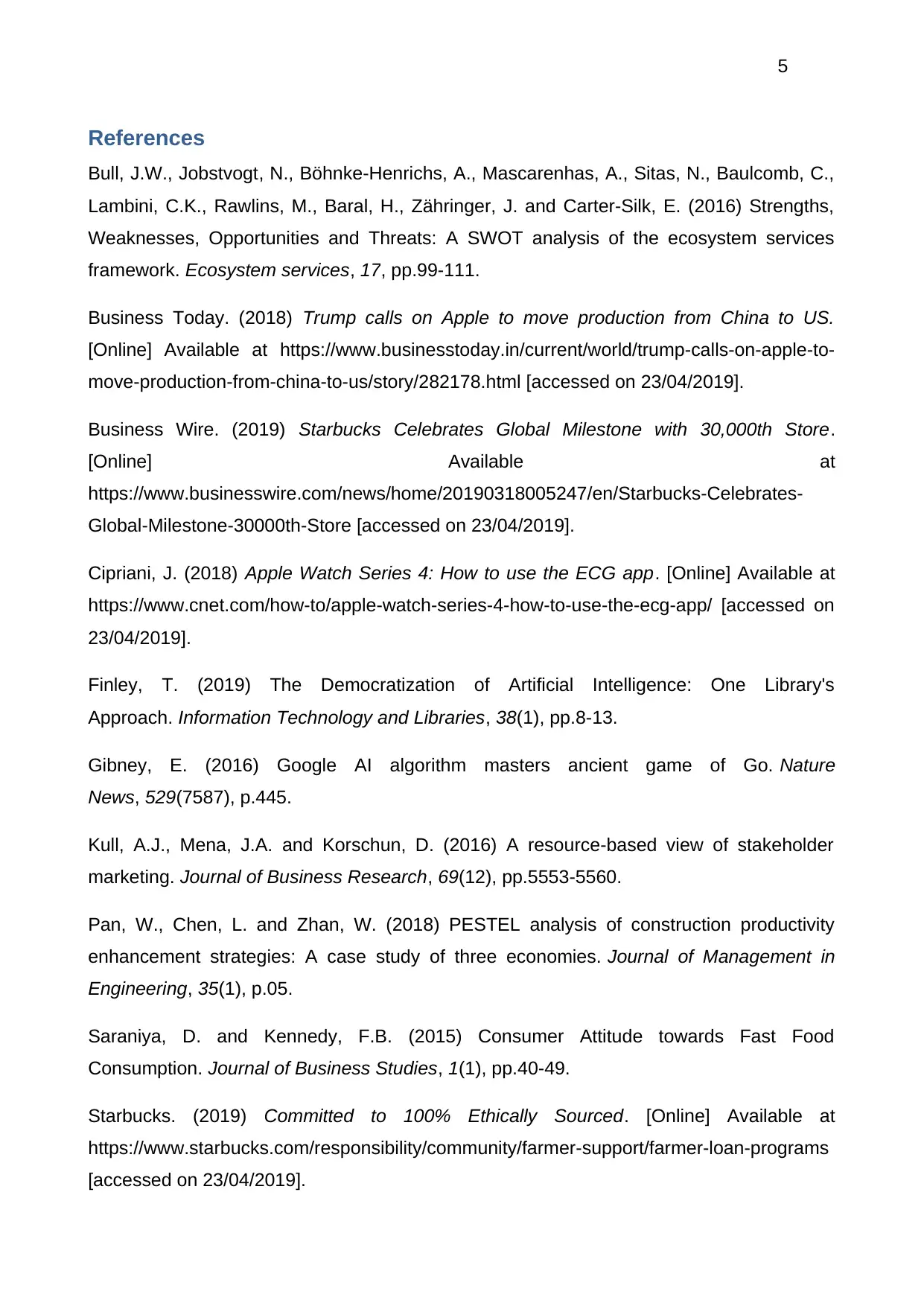
5
References
Bull, J.W., Jobstvogt, N., Böhnke-Henrichs, A., Mascarenhas, A., Sitas, N., Baulcomb, C.,
Lambini, C.K., Rawlins, M., Baral, H., Zähringer, J. and Carter-Silk, E. (2016) Strengths,
Weaknesses, Opportunities and Threats: A SWOT analysis of the ecosystem services
framework. Ecosystem services, 17, pp.99-111.
Business Today. (2018) Trump calls on Apple to move production from China to US.
[Online] Available at https://www.businesstoday.in/current/world/trump-calls-on-apple-to-
move-production-from-china-to-us/story/282178.html [accessed on 23/04/2019].
Business Wire. (2019) Starbucks Celebrates Global Milestone with 30,000th Store.
[Online] Available at
https://www.businesswire.com/news/home/20190318005247/en/Starbucks-Celebrates-
Global-Milestone-30000th-Store [accessed on 23/04/2019].
Cipriani, J. (2018) Apple Watch Series 4: How to use the ECG app. [Online] Available at
https://www.cnet.com/how-to/apple-watch-series-4-how-to-use-the-ecg-app/ [accessed on
23/04/2019].
Finley, T. (2019) The Democratization of Artificial Intelligence: One Library's
Approach. Information Technology and Libraries, 38(1), pp.8-13.
Gibney, E. (2016) Google AI algorithm masters ancient game of Go. Nature
News, 529(7587), p.445.
Kull, A.J., Mena, J.A. and Korschun, D. (2016) A resource-based view of stakeholder
marketing. Journal of Business Research, 69(12), pp.5553-5560.
Pan, W., Chen, L. and Zhan, W. (2018) PESTEL analysis of construction productivity
enhancement strategies: A case study of three economies. Journal of Management in
Engineering, 35(1), p.05.
Saraniya, D. and Kennedy, F.B. (2015) Consumer Attitude towards Fast Food
Consumption. Journal of Business Studies, 1(1), pp.40-49.
Starbucks. (2019) Committed to 100% Ethically Sourced. [Online] Available at
https://www.starbucks.com/responsibility/community/farmer-support/farmer-loan-programs
[accessed on 23/04/2019].
References
Bull, J.W., Jobstvogt, N., Böhnke-Henrichs, A., Mascarenhas, A., Sitas, N., Baulcomb, C.,
Lambini, C.K., Rawlins, M., Baral, H., Zähringer, J. and Carter-Silk, E. (2016) Strengths,
Weaknesses, Opportunities and Threats: A SWOT analysis of the ecosystem services
framework. Ecosystem services, 17, pp.99-111.
Business Today. (2018) Trump calls on Apple to move production from China to US.
[Online] Available at https://www.businesstoday.in/current/world/trump-calls-on-apple-to-
move-production-from-china-to-us/story/282178.html [accessed on 23/04/2019].
Business Wire. (2019) Starbucks Celebrates Global Milestone with 30,000th Store.
[Online] Available at
https://www.businesswire.com/news/home/20190318005247/en/Starbucks-Celebrates-
Global-Milestone-30000th-Store [accessed on 23/04/2019].
Cipriani, J. (2018) Apple Watch Series 4: How to use the ECG app. [Online] Available at
https://www.cnet.com/how-to/apple-watch-series-4-how-to-use-the-ecg-app/ [accessed on
23/04/2019].
Finley, T. (2019) The Democratization of Artificial Intelligence: One Library's
Approach. Information Technology and Libraries, 38(1), pp.8-13.
Gibney, E. (2016) Google AI algorithm masters ancient game of Go. Nature
News, 529(7587), p.445.
Kull, A.J., Mena, J.A. and Korschun, D. (2016) A resource-based view of stakeholder
marketing. Journal of Business Research, 69(12), pp.5553-5560.
Pan, W., Chen, L. and Zhan, W. (2018) PESTEL analysis of construction productivity
enhancement strategies: A case study of three economies. Journal of Management in
Engineering, 35(1), p.05.
Saraniya, D. and Kennedy, F.B. (2015) Consumer Attitude towards Fast Food
Consumption. Journal of Business Studies, 1(1), pp.40-49.
Starbucks. (2019) Committed to 100% Ethically Sourced. [Online] Available at
https://www.starbucks.com/responsibility/community/farmer-support/farmer-loan-programs
[accessed on 23/04/2019].

6
Statista. (2018) Android - Statistics & Facts. [Online] Available at
https://www.statista.com/topics/876/android/ [accessed on 23/04/2019].
Statt, N. (2018) Apple says it’s now powered by 100 percent renewable energy worldwide.
[Online] Available at https://www.theverge.com/2018/4/9/17216656/apple-renewable-
energy-worldwide-climate-change [accessed on 23/04/2019].
Wilson, R.C. (2015) Mayhem: A hands-on case playing activity for teaching Porter’s five
forces to undergraduate business students. Small Business Institute Journal, 11(2), pp.48-
59.
Statista. (2018) Android - Statistics & Facts. [Online] Available at
https://www.statista.com/topics/876/android/ [accessed on 23/04/2019].
Statt, N. (2018) Apple says it’s now powered by 100 percent renewable energy worldwide.
[Online] Available at https://www.theverge.com/2018/4/9/17216656/apple-renewable-
energy-worldwide-climate-change [accessed on 23/04/2019].
Wilson, R.C. (2015) Mayhem: A hands-on case playing activity for teaching Porter’s five
forces to undergraduate business students. Small Business Institute Journal, 11(2), pp.48-
59.
1 out of 7
Related Documents
Your All-in-One AI-Powered Toolkit for Academic Success.
+13062052269
info@desklib.com
Available 24*7 on WhatsApp / Email
![[object Object]](/_next/static/media/star-bottom.7253800d.svg)
Unlock your academic potential
© 2024 | Zucol Services PVT LTD | All rights reserved.





